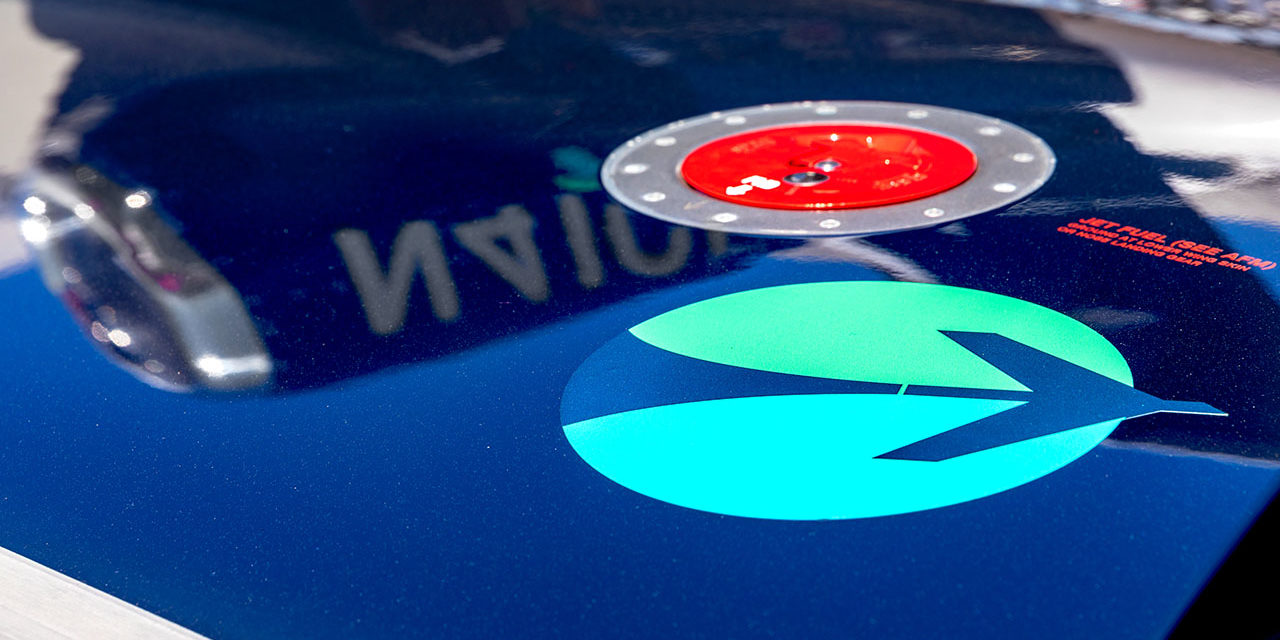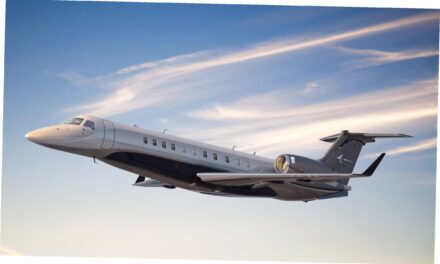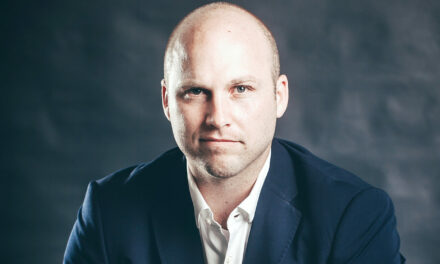This 2019 edition of the European Business Aviation Convention & Exhibition was placed by the organizers under the banner of alternative fuels. A “green” touch, whose main objective is to highlight the efforts made in recent years, particularly by industry, to reduce the environmental impact of private aviation.
A few days before the show, the major manufacturers had gathered at the London Farnborough airport to attend a seminar to promote the development and use of Sustainable Alternative Jet Fuel – SAJF.
In fact, 23 aircraft had moved from their respective homebases with this type of fuel and were exhibited on the static display. “This fleet of 23 aircraft flying into Geneva for EBACE on sustainable aviation fuel represents the global commitment by business aviation to mitigate its carbon emissions, and contribute to the goal of carbon-neutral growth from 2020,” said IBAC Director General Kurt Edwards. “The fly-in also demonstrates the viability of these drop-in fuels, and provides further proof to the industry that we can fly with SAJF now!”
For Kurt Edwards the stakes are all the more important. It is true that it is difficult for business aviation to get out of the picture of an aviation with one of the most pronounced carbon footprints per passenger and per kilometer. However, if until recently, the average number of passengers per plane was about 1.5 people, it tends to increase slightly with a clientele that is less and less reluctant to share its private space with other passengers. This trend is still not widespread but which it is experiencing some growth with a few brokers and operators. Further, in recent years, business aviation has made significant technological advances that have a significant impact on CO2 emissions: more economical engines, new design processes, new light materials, powerful navigation systems, digital documentation, and more.
GAMA President and CEO Pete Bunce said : “As an industry, we are extremely proud to have delivered a 40 percent fuel efficiency improvement over the last 40 years through improved aircraft and component designed materials and manufacturing processes. We look forward to building upon these efficiency gains, which directly translate to our industry’s environmental sustainability goals through the growing availability and use of SAJF.”
The financial efforts made in recent years by manufacturers to develop new alternatives show a real awareness of manufacturers and industry players in the search for a greener aviation. Always criticized, this industry is nonetheless the industry sector, the most advanced on the subject. Many others sectors, less publicized, have still not done the financial efforts to redesign their “ecosystem”.
Textron Aviation: a good 2018 vintage
For this “green” edition, the organizers have seen a rise in exhibitors, with more than 400 booths and 58 aircraft on the static display. According to Ed Bolen, NBAA President : “EBACE2019 provided a clear look at the future of business aviation, making the show more important than ever.”
A remarkable edition, according to Ed Bolen, that confirm numbers of recovery rather encouraging in the opinion of some aircraft manufacturers including Textron Aviation. Rob Scholl, senior vice president of sales and marketing, said that the year 2018 “was undoubtedly one of the best in its last ten years for Textron Aviation”. These good results were obtained in particular with the rise of the Citation Latitude on the market, especially in Europe. The 100th Citation Latitude was due to be delivered to Netjets early this summer, allowing Textron Aviation to enter the segment of “special mission” jets dedicated to a wide range of operations such as medical evacuations or intelligence platform for example. Textron Aviation has already successfully explored this parapublic and military market with its King Air. And, for the first time, on the static exhibition, the manufacturer of Wichita was displaying a Latitude, operated by Babcock, fully equipped for medical evacuation missions – Medevac. In addition to the Latitude, the manufacturer also mentioned the Longitude whose certification, slightly delayed should intervene in the fourth quarter of 2019. Textron Aviation also made the point on its single turboprop, the Denali, powered by the GE Aviation Catalyst engine. Textron Aviation said that the the prototype whose completion is in the final phase, could make its maiden flight by the end of this year and announced a US certification in 2021. Five prototypes will be built to validate the entire program, including two for flight tests and three for ground tests.
Gulfstream is already looking to the future
Like Textron Aviation, Gulfstream is enjoying a boom period despite a difficult market. After having delivered 121 aircraft in 2018, the manufacturer is about to release 145 machines from its Savannah factories in 2019. So, the manufacturer had come again with its entire range and especially the last two models the G500 and the recently certified G600. And this, despite the delay on the G500 and G600 programs, due to the failure of an OEM and the delay in certification of the G600 caused by the three-month shutdown of the US administration, the longest it has ever known. However, Gulfstream, which has no direct competitor on these models, should not suffer too much from these delays. On the contrary, these risks could even allow him to gain some additional market share on a segment left vacant by Dassault Aviation, which was unable to release the Falcon 5X.
With the entry into service of these two jets, Gulfstream is nonetheless attached to the evolution of its existing range, starting with its flagship, the G650ER. This summer, the aircraft should indeed benefit from the US certification for its Enhanced Flight Vision System – EFVS, which will be followed next year by the European Aviation Safety Agency – EASA certification. The aircraft manufacturer is also working to give the aircraft short take-off and landing capabilities to use specific airports such as London-City. The manufacturer’s design office, which is working hard on the improvement of the existing range, would also work on the advanced design of two new programs, a possible competitor to the Global 7500 and a model to replace the G450. This information is not confirmed by Gulfstream but it takes more and more resonance, especially with some equipment manufacturers.
Sun and clouds at Bombardier
The Canadian manufacturer has never looked so good despite the recent sale of several of its various aerospace divisions. After selling the CSeries to Airbus in 2018 and the Dash 8 program to Longview Capital (Viking Air), Bombardier sold the CRJ range early in the summer to Mitsubishi Heavy Industries (MHI). Only the business aviation range, including the Global, Challenger and Learjet families, remains within the Bombardier Aerospace division. Will the Canadian group still maintain an aeronautical activity in the medium term? Even if many analysts have not yet the answer, the manufacturer remains nonetheless very reactive in the sector by announcing various innovations like the Nuage seat and the Nuage chaise – business aviation’s first and only lounge chair that converts into a flat surface for sleeping or banquet-style dining around the conference grouping table. For now, this option is exclusively reserved for future owners of Global 5500 and 6500.
The first Global 6500 series is currently under development at the Montreal Finishing Center.
Another important innovation previewed during the show: the Soleil lighting system, the industry’s most advanced cabin lighting technology. Designed and developed exclusively for the Global 7500, the innovative Soleil lighting system is aviation’s first circadian rhythm-based cabin lighting technology fully integrated with the Flight Management System, and it introduces the revolutionary Dynamic Daylight Simulation feature, which can help combat jet lag. The Soleil lighting system is fully integrated into the Global 7500 aircraft’s nice Touch cabin management system, and can also be customized to a passenger’s preference for either extended sleep or productivity via the system’s unique circadian adjustment setting. The Soleil lighting system can also conveniently be programmed to schedule the optimal times for meal services, allowing the cabin crew to better prepare and plan more efficiently.
Beyond these innovations, Bombardier has given information on the Global 5500 and 6500. The manufacturer planned a certification of the 6500 by the end of 2019. The entry into service will take place immediately after.
The three prototypes have already achieved more than 90% of the test program from the manufacturer’s Wichita site. Let’s recall that the Global 5500 and 6500 are respectively derived from the Global 5000 and 6000. With a new wing, both versions are equipped with the new Rolls-Royce Pearl 15 engine. This gives the aircraft a significant reduction in fuel consumption and a new autonomy, increased by more than 500 nm compared to previous versions. Bombardier also reported on the Global 7500, the first of which went into service in December 2018. According to the aircraft manufacturer, only two 7500 entered into service in early 2019, but the manufacturer announced that the production rate of the Global 6500 – 7500 family will rise to 20 by the end of 2019 and around 40 by 2020.
As for the Challenger range, Bombardier has confirmed improvements to its Challenger 350. Implemented this year, these changes include a new rudder and a new braking system, as well as the integration of the head-up display and an improved vision system as standard equipment. The aircraft will also be equipped with new acoustic insulation that reduces cabin noise levels by 1-2 dB SIL, and up to 4-5 dB SIL compared to previous Challenger 300 series.
Falcon 6X on the right track
Dassault Aviation has announced that it has completed the critical design review of its Falcon 6X, thereby freezing the detailed design of its jet. The Saint-Cloud aircraft manufacturer can now start manufacturing the first parts of the aircraft, and schedule the assembly of the first aircraft by the beginning of 2020. On the engine side, the manufacturer indicated that the Pratt & Whitney Canada PW812D had accumulated nearly 1,000 hours of operation on the test bench in Montreal. Pratt & Whitney Canada has worked more than 13,000 hours on the core variant of Dassault Aviation’s model-specific PW812D. For Eric Trappier, Chairman and CEO of Dassault Aviation “the progress of the program reflects the excellent work performed by our design teams and partners”. Eric Trappier also echoed his perception of the market and said that “despite a sustained recovery in the second-hand market, overall activity was much slower than expected. On the one hand, we see some potential for improvement in the Americas, with the US economy being very active and the economic environment improving in South America, and especially in Brazil. Prospects in Southeast Asia also look better. But on the other hand, the Chinese market has remained stable and activity in Europe has not been particularly robust. ” While these contrasting conditions make it difficult to forecast the market trend, the manager also highlights “uncertainties such as Brexit and its tariff threats”. However, Dassault Aviation remains optimistic and, like Textron Aviation, put on the sector of multirole aircraft. Dassault Aviation, which recently signed a contract for a sixth Falcon 2000 maritime surveillance aircraft with the Japanese Coast Guard, confirms that the demand for multi-role aircraft is growing in Europe. And especially in France for Falcon 2000 maritime surveillance for the Navy and for the Falcon 8X which seems to be privileged in the French program Epicure / ELINT.
TBM940 certification
Officially launched just two months before Ebace, the new evolution of Daher’s single turboprop engine, the TBM 940, received its certification during the show. This new iteration of the iconic aircraft, created 29 years ago is supplanting the 930 model introduced on the market in 2016.
The $ 4.13 million new model has already been ordered to 25 copies according to the manufacturer. Among the main improvements made to this new version, are the integration of an autothrottle as well as an automatic icing detection system. The TBM 940 also features a new interior with enhanced sound proofing insulation.
Three ACJ350 for Germany
If the industrial accident of Boeing and its 737 Max does not yet officially benefit to the Airbus ACJ range, the european aircraft manufacturer however announced during the show that he had won at the beginning of the year a prestigious contract with the German government. The latter, which is already operating four Airbus models (two A340s and two ACJ319s) and four Global 5000s, has ordered three ACJ350-900 XWBs, becoming the first government customer for this type of aircraft, which is also ordered by private customers. The multimission aircraft will be used both for government transport, troops and medical evacuations. The cabin layout will rely on the ACJ’s Easyfit Cabin Equipment concept, which includes pre-installed accessories and standardized interfaces to simplify the installation of walls and furniture. The first aircraft will be delivered in 2020, and the two others in 2022.
The Praetor range soon in service
Embraer can boast that it has completed its Praetor program on time. Eight months after the official launch of the two aircraft, the Brazilian manufacturer has received type certification for its Praetor 600 from the FAA (Federal Aviation Administration) and the EASA (European Aviation Safety Agency). The Praetor 500 will be certified, according to the manufacturer, by the end of 2019. The introduction of these two new models does not mean, according to Embraer, the end of Legacy 450 and 500 from which they are directly derived. However, Embraer said that it would offer owners of previous versions, the possibility of a retrofit of their aircraft and that it will be available first on the Legacy 450 for a transformation into Praetor 500. No price has been specified. As far as the the rest of its range is concerned, Embraer still indicates a strong demand for its Phenom models, and especially for its new 100E and 300E versions. As such, the manufacturer holds for the seventh consecutive year, the first place in number of aircraft delivered in the segment of light jets. A record that could well continue this year again.
Record delivery year for HondaJet
The launch in 2018 of the Elite version of the HA-420 seems to have succeeded to the Japanese manufacturer. HondaJet has indeed announced having delivered 37 aircraft in 2018, more than Cessna and its Citation M2 and Embraer with its Phenom 100E.
A total of 123 aircraft are currently in service with an availability rate close to excellence (99.7%) according to Hondajet Chief Executive Officer Michimasa Fujino. With a backlog of over a year of production, the manufacturer has also announced the expansion of its Greensboro, North Carolina facilities. The work began in July 2019. Covering an area of 7,600 m2, the new unit will be used for wing assembly and parts storage and is expected to open in July 2020.
Pilatus reopens the PC-24 order book
The Swiss manufacturer has announced this year that he opened again the PC-24 order book, like during the 2014 Ebace convention. At that time, Pilatus sold 84 PC-24s in a day and a half. The order book was then closed until the the first deliverries to customers. Delivery positions for orders placed during this 2019 edition are scheduled for the end of 2020 to 2021. Pilatus plans to deliver about 40 PC-24 in 2019 and to increase the production rate to 50 aircraft in 2020.
Since the first delivery in February 2018 Pilatus has delivered 30 PC-24.
The leader of the fleet PC-24, serial number 101, owned by PlaneSense, has already flown more than 1,100 hours during its first 15 months of operation. The total PC-24 fleet has accumulated more than 5,000 flight hours. For Oscar J. Schwenk, President of Pilatus, the demand for the PC-24 “is phenomenal”. According to the CEO, “From the first day, different customer segments around the world have shown a strong interest. The returns we have from the 30 PC-24 operators are extremely positive, with special mention for the versatility of the aircraft, its spacious and quiet cabin, and incredible performance. These remarks confirm the initial strategy we chose for PC-24 “.
The twinjet which had received EASA and FAA certifications for use on unpaved runways is particularly appreciated for its multi-role capability, especially at Royal Flying Doctor Service of Australia.
Parallel work allowed the aircraft manufacturer to obtain a complementary certification from the two agencies for grass runways operations and for steep approaches, such as London City Airport.









